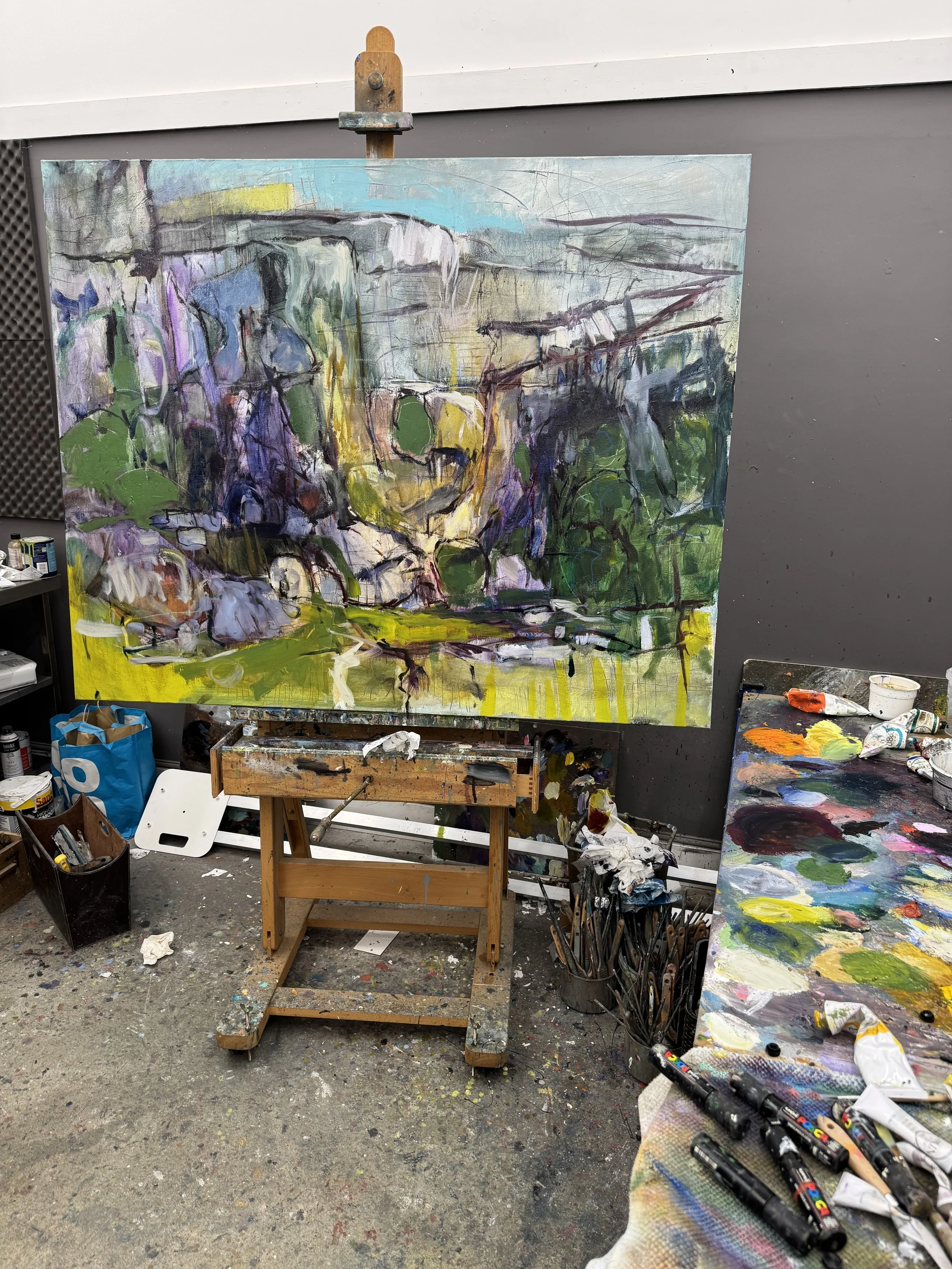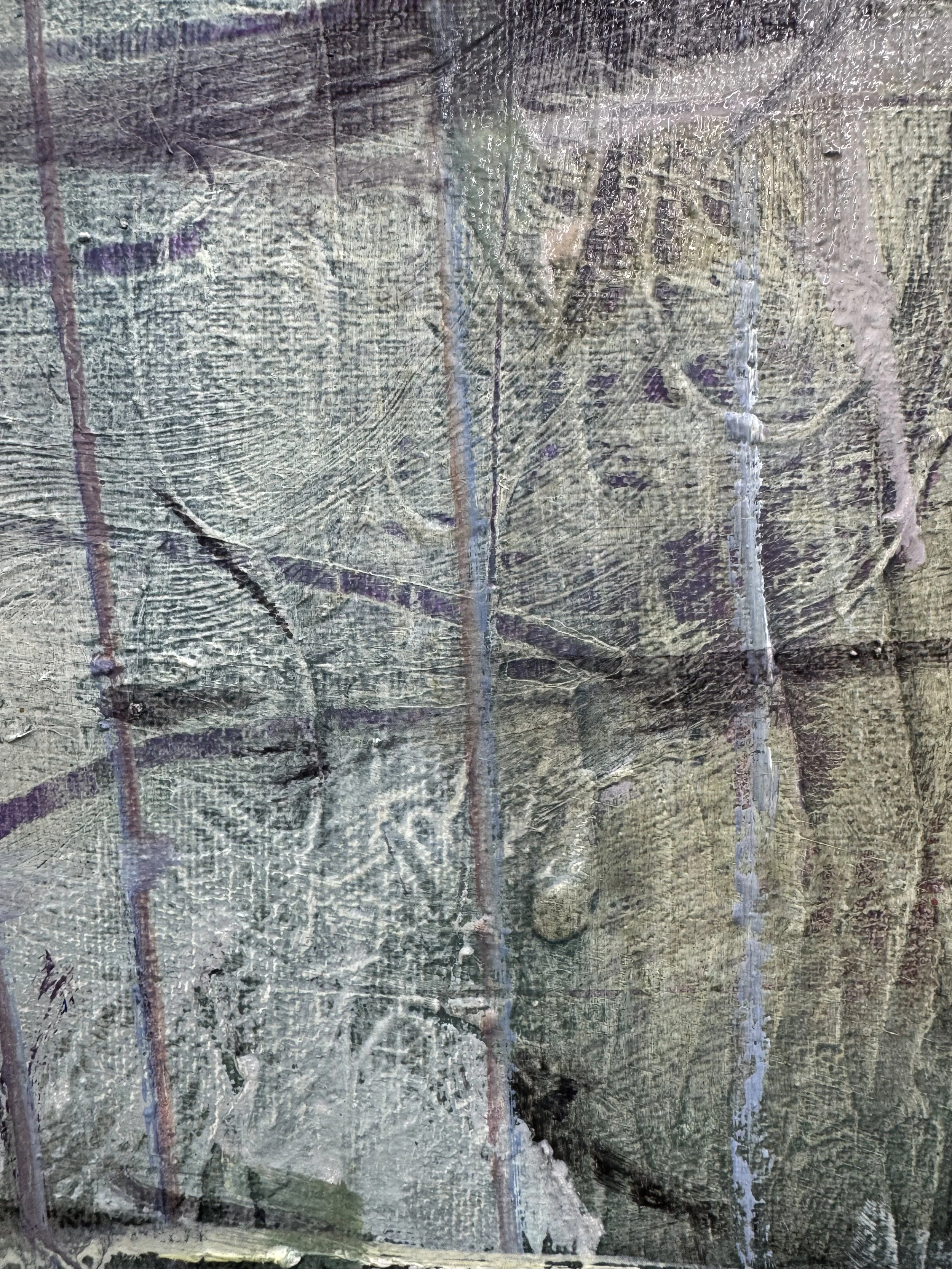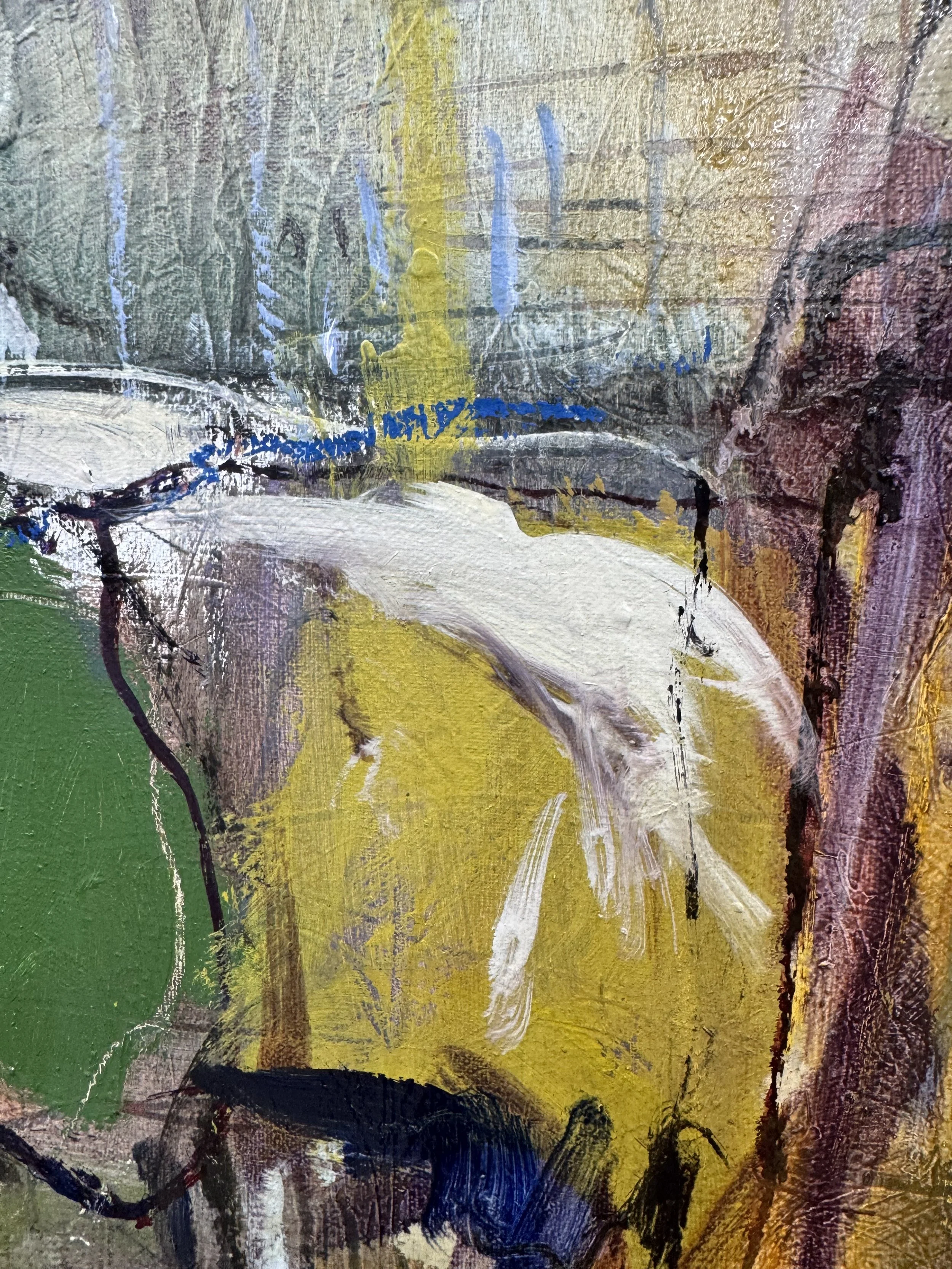Fracture: Modernist Ground, Northern Weather
If traditional landscape offers the comfort of a view, Fracture offers a condition: an ecology of perception in which the Dales—and particularly Penhill and the surrounding limestone country—are not depicted so much as enacted
Painting, perception, and the sculptural sublime of the Dales
Fracture is a sustained inquiry into the liminality of perception and the unstable ways in which we locate ourselves in the world. It is a body of work that begins with the material presence of paint and ends in the uncertainty of vision; it asks what it means to belong not to a mapped place but to a sensed, fractured field of becoming. Drawing upon the philosophical condition of becoming, these works refuse to settle into the certainties of place or representation. Instead, they hover in the interstice between presence and absence, offering only fragments—material traces, gestures, and chromatic echoes—through which a sense of place emerges.¹
If traditional landscape offers the comfort of a view, Fracture offers a condition: an ecology of perception in which the Dales—and particularly Penhill and the surrounding limestone country—are not depicted so much as enacted. Paint is not a vehicle but a collaborator: recalcitrant, entropic, suggestive. Distressed, accreted surfaces—often literally incorporating limestone dust—open what Deleuze calls a zone of indiscernibility, where figure and ground, past and present, material and image dissolve into one another.² In this liminal suspension, perception remains fluid; meaning never quite seals. Fracture becomes generative rather than catastrophic: the fissure through which the world discloses itself.
Distressed, accreted surfaces—often literally incorporating limestone dust—open what Deleuze calls a zone of indiscernibility, where figure and ground, past and present, material and image dissolve into one another
Seen in relation to modernist lineages, the project clarifies both its continuities and its refusals. From Constable’s meteorological empiricism to Cézanne’s dismantling of the unitary viewpoint, modern painting repeatedly re-set the terms of landscape as a problem of seeing rather than a repertory of motifs.³ If Cézanne’s Mont Sainte-Victoire is the archetype of a motif used to interrogate perception, Penhill functions here as a contemporary analogue: a northern hill returned to, not for its postcard silhouette, but for the way it pressurises pictorial decisions—range and weight, mass and void, fracture and accretion.⁴ Yet where Cézanne fractured perception to reconcile vision into a new order, Fractureaccepts a contemporary irresolution. The image is held open, neither collapsing into description nor evaporating into pure material. This places the work in dialogue with a post-Greenbergian materialism—insisting on paint’s factuality without renouncing image; defending ambiguity as a mode of truth, not a failure of finish.⁵ If modernism pursued truth to materials, Fracture pursues truth to perception’s instability.
Placed within the context of Northern painters, the project also resonates with Sheila Fell, Norman Ackroyd, and Percy Kelly, who each in their own ways grasped landscape as lived weather rather than scenic report. Fell’s Cumbrian canvases are a powerful precedent in tonal gravitas, where terrains are shaped as much by geology and labour as by light, planes weighed before they are depicted.⁶ In Fell, the human and the elemental are co-implicated: farm buildings are not ornaments in nature but structures of endurance within it. Fracture takes from Fell the conviction that the north is not a genre but a pressure system—and extends it by letting weight migrate from motif to material (limestone charge, bitumen gloss, scumbled oil), so that the ground itself bears the history it images.
Ackroyd, by contrast, renders the British archipelago in etchings of tempestuous reserve. His sheets are distillations—air, water, rock reduced to etched weather.⁷ Where his bite and aquatint abstract landscape into tonality and edge, Fracture asks what happens when the same distillation occurs through built surface: not biting copper, but eroding and rebuilding a ground until image precipitates. The aim is similar—clarity at the edge of recognition—but the means are painterly and geological rather than graphic and aqueous.
Kelly provides a third, salutary angle: an artist of edges, vernacular structures, and insistent line.⁸ His black architectures make place through outline and insistence, the stubbornness of things. Fracture departs here, softening outline into porous seam; but it shares Kelly’s refusal of the merely picturesque. Where Kelly holds the world with line, Fracture holds it with mass: the felt pressure of cliff, scarp, and cloud-weight—Penhill as keel more than view. Together, Fell, Ackroyd, and Kelly frame a Northern modernism that is neither folkloric nor sentimental: a discipline of restraint and structural clarity. Fracture adds a fourth vector—entropic materiality—to this discipline, pushing from depiction toward embodied geology.
If the Dales are limestone country, the paintings bring that calcium memory into the work. Limestone dust—sieved, slaked, and bound—enters the paint film to produce a sedimentary surface: built, abraded, recommenced. These are not effects; they are causes. The resistant tooth changes how a mark can be made; the porous ground drinks oil, muting chroma and thickening time. The result is a surface that remembers process as rock remembers pressure. In Greenberg’s vocabulary this could be called “truth to materials,” but that phrase is too sleek for what happens here.⁹ The material is not simply honoured; it answers back. The painter’s intention meets the ground’s refusal—a negotiation that keeps the image contingent, provisional, alive to accident as intelligence. As Gombrich noted, perception completes from fragments; here the fragments are literal.¹⁰
This sense of mass leads inevitably to a discussion of monumentality, and here Henry Moore becomes a crucial interlocutor. Monumentality is often mistaken for size, but Moore reminds us it is a quality of form—the felt relation of mass, void, and contour that makes a small sculpture carry the gravity of a hill.¹¹ Fracture pursues monumentality as a painterly condition: massed ranges of value functioning like sculptural volume; open forms (erosion, hole, cleft) admitting air; silhouettes that read like weathered profiles rather than scenic outlines. Two aspects of Moore’s thinking are especially germane. First, the idea of the internal space—the hole not as absence but as positive form. In Fracture, this translates into apertures of pale ground or scumbled air that are not gaps in painting but sites of force: the wind-pass, the beck-cut, the limestone swallow hole. Second, Moore’s practice of reading natural forms as sculpture—flints, bones, stones—encourages an equivalence between found geology and built form.¹² In Fracture, Penhill and the geology of the Dales is read as if it were a Moore: up-thrust, counter-mass, traverse; and the painting is built as if it were a small hill: layer, crush, seam.
Equivalence here is not metaphor (“the painting is like a sculpture”) but method: the picture is constructed rather than filled. Grounds are laid not as backgrounds but as sub-strata; subsequent passages key into earlier deposits; planes are carved out with range and temperature rather than modelled with descriptive light. Edges are not drawn; they are broken, their energy distributed across zones like a chisel’s shock through stone. This is where Cézanne’s Mont Sainte-Victoire returns as a technical ancestor. His shifting planes tempered spatial description into a built surface; Fracturepresses further, letting surface precede description. The hill is true if the structure is true; likeness becomes a by-product of organised mass. Seen this way, Fracture is less a landscape project than a proposal about how painting thinks: by accumulation, erasure, pressure, and release—the same verbs by which a sculptor works material. That the Dales are the motif is neither incidental nor tyrannical; it is congruent. Limestone is a didactic geology: layered, jointed, repeatedly tested by weather. The paintings adopt the same grammar.
The Dales, of course, have suffered a century of being loved into cliché. The answer is not to renounce their beauty but to re-apprehend their elemental condition. The sublime, in the north, is rarely bombast; it is pressure and exposure—weather moving on mass, mass enduring weather. Liminal perception—what Fracture seeks and stages—meets this sublime with adequate means: not point-of-view description, but the suspension in which matter and image are kept in dynamic tension. Sculptural responses—whether literal, as in Moore’s bronzes drawn from Yorkshire geology, or painterly, as here—release the Dales from their postcard destiny. They return landscape to force and structure, to time made visible in seam and scarp. In such work the hill is not what we look at but what we look with: an engine for thinking form, weight, interval, and the mutual making of place and self.
Grounds are laid not as backgrounds but as sub-strata; subsequent passages key into earlier deposits; planes are carved out with range and temperature rather than modelled with descriptive light
To encounter these works is to be drawn into fracture itself—not as rupture or breakage, but as the generative condition of perception. Fracture is the moment before recognition, when seeing remains fluid, when meaning is not yet fixed but held in suspension. In this liminal state, painting becomes a practice of becoming: never fully resolved, always on the edge of disclosure. Place becomes relation rather than record; belonging becomes practice rather than possession. If Fell gives us weight, Ackroyd weather, and Kelly edge, Fracture brings mass—a Moore-like sense that form can be both stone-true and open to air. In that equivalence between painting and sculpture lies the argument: that the sublime landscape of the Dales is most truthfully apprehended when treated not as a view to be framed but as a form to be built, tested, and endured. Only then is the postcard retired and the elemental restored.
Notes
Gilles Deleuze, Difference and Repetition (London: Continuum, 1994), 35–40; cf. Deleuze and Félix Guattari, A Thousand Plateaus (London: Athlone, 1987), 263–66.
Deleuze and Guattari, A Thousand Plateaus, 263–66.
John House, Constable and the Pursuit of Nature (London: Tate, 1983); Richard Shiff, “Cézanne and the Practice of Painting,” in Critical Terms for Art History, ed. Robert S. Nelson and Richard Shiff (Chicago: University of Chicago Press, 2003), 47–65.
On motif as laboratory, see Meyer Schapiro, “The Apples of Cézanne,” Art News Annual 34 (1966), 54–63.
Clement Greenberg, “Modernist Painting” (1960), in Art and Culture: Critical Essays (Boston: Beacon, 1961), 85–93.
See Cate Haste, Sheila Fell: A Passion for Paint (London: Lund Humphries, 2010).
Norman Ackroyd, A Shetland Notebook (London: Royal Academy, 2014); see also RA exhibition catalogues on Ackroyd’s coastal etchings.
Chris Wadsworth, Percy Kelly: The Man Who Couldn’t Stop Drawing (Carlisle: Bookcase, 2010).
Greenberg, “Modernist Painting.”
E.H. Gombrich, Art and Illusion: A Study in the Psychology of Pictorial Representation (London: Phaidon, 1960), 181–206.
Alan Wilkinson, Henry Moore Remembered: The Collection at the Art Gallery of Ontario (Toronto: AGO, 1987); Henry Moore, “Notes on Sculpture,” in Henry Moore: Writings and Conversations, ed. Alan Wilkinson (London: Lund Humphries, 2002).
Moore, “Notes on Sculpture”; see also his collected Writings and Conversations for the treatment of natural forms as sculptural prompts.


